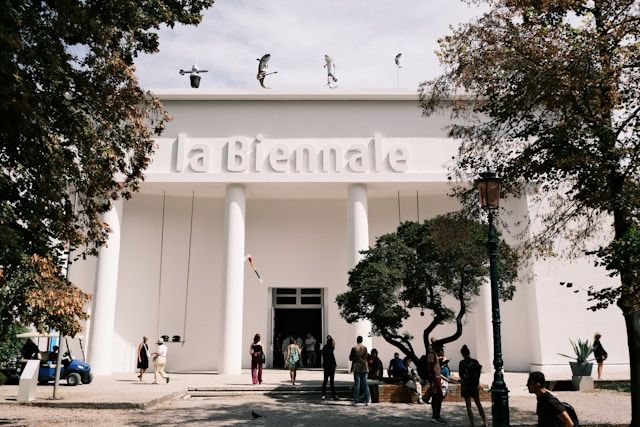Hey dear traveler, today we're diving into a truly unique experience: visiting the Venice Architecture Biennale in one day. Yes, you heard that right!
While it might sound like a challenge, with the right mindset and a well-planned guide, it’s absolutely doable.
Let’s discover everything in this guide by Venice Insider Guide, designed for those who want to immerse themselves in the fascinating world of international architecture, even with limited time.
Visiting the Venice Architecture Biennale in one day: Yes, you can

Every two years, Venice becomes a grand stage where the brightest minds in contemporary architecture showcase their most compelling visions. The Architecture Biennale spans two main venues: the Giardini della Biennale and the Arsenale. Additionally, there are numerous collateral pavilions scattered throughout the city, but for a one-day itinerary, we'll focus on the main ones.
Many believe you need two or three days to appreciate it all, but that's not always feasible. If you're in Venice for just a weekend-or even a single day-don't worry: with precise planning, you can enjoy the highlights of the exhibition and have an enriching experience.
How to visit the Architecture Biennale in one day: Top tips
How to visit the Architecture Biennale in one day? Before diving into installations, pavilions, and visionary projects, here are some practical tips to make the most of your visit:
- Buy your ticket online: save time at the entrance.
- Arrive early: get there right at opening time (usually at 10:00 AM).
- Wear comfortable shoes: you’ll be walking a lot, both indoors and outdoors.
- Bring water and a light snack: there are food areas, but they can get crowded.
- Download the Biennale map: it’ll help you navigate more easily.
- Stay focused: you won’t see everything in a day, so concentrate on key and impactful pavilions.
Best itinerary to visit the Venice Architecture Biennale in one day

Best itinerary to visit the Venice Architecture Biennale in one day? Yes!
Let’s get into the heart of it! Here's a thoughtfully divided itinerary-morning, afternoon, and evening-designed to let you experience the Biennale deeply, without stress. Ready to start?
Morning
The Giardini della Biennale is the perfect starting point. Here you'll find some of the most important and iconic pavilions, such as those of Italy, Denmark, Japan, and others.
- Arrive around 10:00 AM.
- Grab a map and orient yourself among the main pavilions.
- Spend at least 2–3 hours in the Giardini.
- Don’t miss the Central Pavilion, the curatorial heart of the exhibition.
This is the time to absorb the most provocative and visionary projects, many of which are housed here. Take a break in the gardens with a coffee before heading out again.
Afternoon
After lunch, head over to the Arsenale, the second core site of the Biennale.
- Take the vaporetto (line 1 or 6) or enjoy a 15–20 minute walk along Riva degli Schiavoni.
- The Arsenale is more linear, making it easier to explore in sequence.
- Here you’ll find a variety of projects, installations, and immersive videos.
From 2:00 PM to 5:00 PM, explore the Arsenale and be swept away by the dialogue between architecture, technology, and society. This section often stands out for its interactive exhibits.
Evening
If you still have energy left, wander back toward the city center to visit collateral pavilions scattered around Venice, such as those near Santa Maria della Pietà or Campo San Lorenzo.
Or, why not unwind in a local bacaro with a cicchetto and a glass of wine, reflecting on the wonders you saw during the day?
Most pavilions close at 6:00 PM, so make the most of every minute!
Must-see Pavilions at the Venice Architecture Biennale in One Day
Let’s dive into the national pavilions at the Venice Architecture Biennale in one day you absolutely shouldn’t miss. Choosing is tough, but here are our top recommendations.
Italy
The Italian Pavilion is always one of the most anticipated. Each edition offers reflections on the national urban landscape, suburbs, and contemporary living.
Usually located at the Arsenale, it surprises visitors with its multidisciplinary approach: installations, videos, sounds, and tactile materials. A snapshot of Italy’s urban challenges and innovations.
Denmark
Located in the Giardini, the Danish Pavilion stands out for its refined design and sustainable approach. A relaxing space where form and function blend seamlessly.
Themes often include the relationship with water and eco-compatible materials. Take your time here and soak in that Nordic atmosphere.
Netherlands
Also in the Giardini, the Dutch Pavilion frequently impresses with a conceptual, critical approach to urban systems and housing policies.
Expect something unconventional: minimalist installations rich in meaning. A powerful reflection on collective living, inclusion, and sustainability.
Poland
Poland’s presence at the Biennale is always one of the most compelling. The Polish Pavilion offers deep and often provocative insights into space, borders, and memory.
Whether it’s about urban renewal or housing experiences, this pavilion emphasizes emotional interaction, turning each visit into an introspective journey.
Japan
Minimalism, poetry, and spirituality-three words to describe the essence of the Japanese Pavilion, located in the Giardini.
Japanese installations communicate a lot with very little. Every detail is thoughtful, every design choice meaningful. A peaceful corner to reflect on the relationship between people and space.
What makes the Venice Architecture Biennale unique?
The Venice Architecture Biennale is more than an event: it's a moment of global convergence where innovation, criticism, and artistic vision meet in a spectacular setting. Known locally as La Biennale di Venezia, this internationally renowned exhibition transforms Venice into a pulsating heart of architectural dialogue every two years.
From its main exhibition to special projects, guided tours, and collateral events, the Biennale touches on pressing topics, from sustainability to urban resilience, from restoration work to digital futures. It's a celebration of space, structure, and the social fabric that binds them.
Two venues, one experience
The Biennale’s two venues, the Giardini and the Arsenale, are essential to your itinerary. These historic sites host the international architecture exhibition and dozens of national pavilions.
The Giardini-home to the Central Pavilion and 29 permanent national pavilions like the British Pavilion, Spanish Pavilion, and Japanese Pavilion-is a feast of diversity and design. A short walk through tree-lined paths leads you from one national story to another.
The Arsenale, a former naval dockyard, is where imagination runs wild through immersive installations. The Sale d’Armi wing often hosts thought-provoking special events and workshops, while the long galleries echo with ideas curated from across the globe.
National Pavilions: A global conversation
Each pavilion presents a unique project that reflects the nation’s architectural stance. Whether you're admiring the adaptive reuse featured in the Polish Pavilion, the circular economy concepts in the Dutch Pavilion, or the serene minimalism in the Japanese Pavilion, every pavilion offers a great opportunity to understand how space and identity interact.
These historic pavilions are not only visually stunning, but also rich in contemporary art and experimental concepts. Some even explore the fragile ecosystem of Venice, connecting global issues with local urgency.
Practical information: Tickets, access, and routes
To make the most of your day, purchase admission tickets in advance-one entry gives access to both main venues. Ticket prices vary for students, visitors, and groups, but there are discounts for under-26s and seniors. Keep in mind the opening hours (usually 10 AM–6 PM) and opening days, as the Biennale is closed on certain Mondays.
The entrance to the Giardini is on Viale Giuseppe Garibaldi, while the Arsenale is a ten-minute walk away along the Riva degli Schiavoni-a pleasant stroll with beautiful views of the Grand Canal and San Marco’s skyline.
For those looking for curated insights, Biennale Sessions and guided tours are available upon booking. These add value, especially if you're interested in architecture, art, and the role of design in shaping societies.
Venice itself: A living exhibition
Remember, the city of Venice itself is an exhibition, an open-air museum where history and innovation coexist. While exploring various locations of the Biennale, take moments to rest and admire the city’s timeless beauty.
The Gallerie dell’Accademia, San Marco, and the hidden courtyards near the Biennale venues are perfect for a reflective walk. You’ll see how architecture isn't just in the pavilions, but everywhere-woven into walls, streets, and piazzas.
Don’t forget to check out special events curated by prominent artists, architects like Carlo Ratti, and collectives focused on urban transformation. Their work often spans museums, churches, and unconventional spaces.
A day to remember
You may be visiting for just one day, but the memories will linger. From the British Pavilion’s critique of heritage to Andrea Avezzù’s captivating exhibition photography, from the vibrant crowd of students to the seasoned eyes of architects, every person at the Biennale contributes to a shared cultural experience.
Take your time to explore, pause, save your favorite exhibits, and enjoy a bite or drink by the water. Venice knows how to welcome dreamers and thinkers.
Whether it’s your first time or your fifth, the Venice Biennale always offers something new. It’s not just about access to great architecture: it’s about understanding how we live, connect, and build a future, one pavilion at a time.
One-day Venice Architecture Biennale: Final thoughts
One-day Venice Architecture Biennale is the feasible.
Visiting the Architecture Biennale in just one day is not only possible, but it can be truly unforgettable. With good planning, curiosity, and passion, you’ll discover a world of ideas, cultures, and visions that go far beyond the confines of architecture.
Remember: you don’t need to “see it all” to grasp the essence of the Biennale. Just let yourself be inspired.

